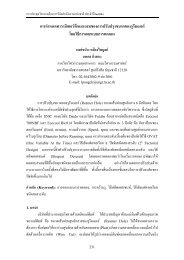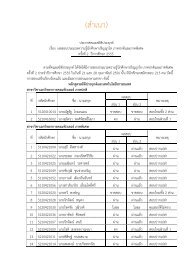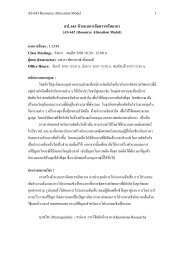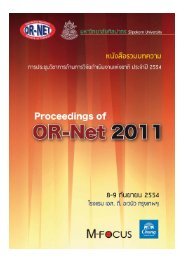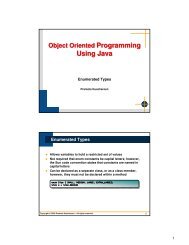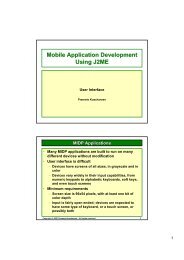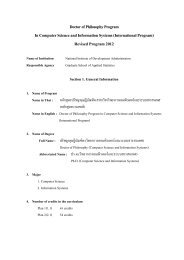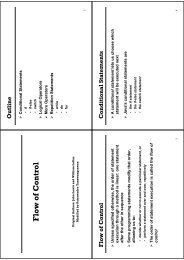Chapter 10 - AS Nida
Chapter 10 - AS Nida
Chapter 10 - AS Nida
You also want an ePaper? Increase the reach of your titles
YUMPU automatically turns print PDFs into web optimized ePapers that Google loves.
<strong>Chapter</strong> <strong>10</strong><br />
Specification Limit<br />
Process Capability, and Gage<br />
Measurement
Specification limit<br />
• Specification limit : conformance boundary<br />
specified formal characteristic.<br />
• Type of Specification<br />
– Two-sided : upper and lower limits<br />
– One-sided : either an upper or lower limit
Statistical tolerance limits<br />
• Statistical tolerance limits: limits of the<br />
interval for which it can be stated with a<br />
given level of confidence that it contains at<br />
least a specified proportion of the<br />
population.
Setting Up Statistical Tolerance<br />
Limit<br />
• Use control chart to measure of process<br />
capability to established requirement<br />
• From observations of a given quality<br />
characteristics from one or more samples.
Statistical tolerance limits<br />
• When process is in control, data can be used to<br />
determine statistical tolerance limit.<br />
• Assume that a process involves a quality<br />
characteristic that follows a normal distribution<br />
with mean µ, and standard deviation, σ. The upper<br />
and lower natural tolerance limits or statistical<br />
tolerance limits of the process are<br />
UNTL = µ + 3σ<br />
LNTL = µ -3σ
Statistical Tolerance Limits<br />
• Page 325<br />
• Obtain a sample of n observation<br />
• Check for normality assumption<br />
• Calculate statistics parameters<br />
• Select the desired confidence level and<br />
population proportion to be cover by limits<br />
• Determine k2 • Compute limits
Types of specification conflict<br />
• Type I : distribution too wide for double<br />
specification<br />
• Type II : Distribution not centered correctly<br />
for single specification limit<br />
• Type III : Specification limits too wide for<br />
acceptable product
Type I : distribution too wide for<br />
• Possible action<br />
double specification<br />
– Changing the process<br />
– Changing the specification<br />
– Setting up an inspection/sorting operation to<br />
find, remove, or repair the units of product<br />
falling outside either specification limit<br />
– Adjusting centering of distribution to strike a<br />
balance among relative costs
Type II : Distribution not centered<br />
correctly for single specification limit<br />
• Possible action<br />
– Attempting to center the process at a value far<br />
enough from specification limit<br />
– Changing the specification limit<br />
– Setting up inspection/sorting operation to find<br />
and remove or repair the units of product that<br />
fall out side the specification limit
Type III : Specification limits too<br />
wide for acceptable product<br />
• Possible action<br />
– Conducting ore formal program of process<br />
experimentation to determine what range of<br />
value cause nonconformities<br />
– Tightening the specification limits<br />
– Establishing shop or manufacturing limits on a<br />
temporary basis until final values are<br />
determined
Process capability analysis<br />
• Process capability refers to the uniformity of the<br />
process.<br />
• Variability in the process is a measure of the<br />
uniformity of output.<br />
• Two types of variability:<br />
– Natural or inherent variability (instantaneous)<br />
– Variability over time<br />
• Process capability analysis is an engineering study to<br />
estimate process capability.<br />
• In a product characterization study, the distribution of<br />
the quality characteristic is estimated.
Major uses of data from a process<br />
capability analysis<br />
1. Predicting how well the process will hold the tolerances.<br />
2. Assisting product developers/designers in selecting or<br />
modifying a process.<br />
3. Assisting in Establishing an interval between sampling<br />
for process monitoring.<br />
4. Specifying performance requirements for new<br />
equipment.<br />
5. Selecting between competing vendors.<br />
6. Planning the sequence of production processes when<br />
there is an interactive effect of processes on tolerances<br />
7. Reducing the variability in a manufacturing process.
Techniques used in process<br />
capability analysis<br />
1. Histograms or probability plots<br />
2. Control Charts<br />
3. Designed Experiments
Process Capability Analysis Using a<br />
Histogram or a Probability Plot<br />
Using a Histogram<br />
• The histogram along with the sample mean and<br />
sample standard deviation provides information<br />
about process capability.<br />
– The process capability can be estimated as<br />
x ±<br />
– The shape of the histogram can be determined (such<br />
as if it follows a normal distribution)<br />
– Histograms provide immediate, visual impression of<br />
process performance.<br />
3 s
Probability Plotting<br />
• Probability plotting is useful for<br />
– Determining the shape of the distribution<br />
– Determining the center of the distribution<br />
– Determining the spread of the distribution.<br />
σˆ<br />
=
Probability Plotting<br />
Cautions in the use of normal probability plots<br />
• If the data do not come from the assumed<br />
distribution, inferences about process capability<br />
drawn from the plot may be in error.<br />
• Probability plotting is not an objective procedure<br />
(two analysts may arrive at different<br />
conclusions).
Process Capability Ratios<br />
Use and Interpretation of Cp • Recall<br />
USL − LSL<br />
Cp =<br />
6σ<br />
where LSL and USL are the lower and upper<br />
specification limits, respectively.
Use and Interpretation of C p<br />
The estimate of C p is given by<br />
Ĉ p<br />
=<br />
USL − LSL<br />
6σˆ<br />
Where the estimate σˆ can be calculated using the sample<br />
standard deviation, S, or R<br />
/ d<br />
2
Use and Interpretation of C p<br />
One-Sided Specifications<br />
C<br />
C<br />
pu<br />
pl<br />
USL − µ<br />
=<br />
3σ<br />
µ − LSL<br />
=<br />
3σ<br />
These indices are used for upper specification and<br />
lower specification limits, respectively
Use and Interpretation of C p<br />
Assumptions<br />
The quantities presented here (C p, C pu, C lu) have some very<br />
critical assumptions:<br />
1. The quality characteristic has a normal distribution.<br />
2. The process is in statistical control<br />
3. In the case of two-sided specifications, the process mean<br />
is centered between the lower and upper specification<br />
limits.<br />
If any of these assumptions are violated, the resulting<br />
quantities may be in error.
Process Capability Ratio an<br />
Off-Center Process<br />
• Cpdoes not take into account where the<br />
process mean is located relative to the<br />
specifications.<br />
• A process capability ratio that does take<br />
into account centering is Cpk defined as<br />
Cpk = min(Cpu, Cpl)
Normality and the Process<br />
Capability Ratio<br />
• The normal distribution of the process<br />
output is an important assumption.<br />
• If the distribution is nonnormal, Luceno<br />
(1996) introduced the index, Cpc, defined<br />
as<br />
C pc<br />
=<br />
6<br />
USL<br />
π<br />
2<br />
E<br />
−<br />
LSL<br />
X<br />
−<br />
T
More About Process Centering<br />
• Cpk should not be used alone as an<br />
measure of process centering.<br />
• Cpk depends inversely on σ and becomes<br />
large as σ approaches zero. (That is, a large<br />
value of Cpk does not necessarily reveal anything<br />
about the location of the mean in the interval<br />
(LSL, USL)
More About Process Centering<br />
• An improved capability ratio to measure process<br />
centering is Cpm .<br />
USL − LSL<br />
Cpm =<br />
6τ<br />
where τ is the squre root of expected squared<br />
deviation from target: T =½(USL+LSL),<br />
τ<br />
2<br />
=<br />
[ ( ) ] 2 2<br />
2<br />
x − T = σ + ( µ T)<br />
E −
More About Process Centering<br />
• Cpm can be rewritten another way: (same as <strong>10</strong>.8)<br />
USL − LSL<br />
Cpm<br />
=<br />
2<br />
2<br />
6 σ + ( µ − T)<br />
where<br />
=<br />
C<br />
p<br />
1+<br />
ξ<br />
2<br />
− µ<br />
ξ =<br />
σ<br />
T
More About Process Centering<br />
• A logical estimate of C pm is:<br />
where<br />
Ĉ<br />
V<br />
pm<br />
=<br />
=<br />
Ĉ<br />
1+<br />
T − x<br />
S<br />
p<br />
V<br />
2
pk<br />
Confidence Intervals and Tests<br />
on Process Capability Ratios<br />
C pk<br />
• Ĉ pk is a point estimate for the true C pk , and<br />
subject to variability. An approximate <strong>10</strong>0(1-α)<br />
percent confidence interval on C pk is<br />
⎡<br />
1 1 ⎤<br />
⎡<br />
⎢1<br />
− Zα<br />
/ 2 + ⎥ ≤ C pk ≤ Ĉ pk ⎢1<br />
+ Zα<br />
⎢<br />
2(<br />
n −1)<br />
⎣<br />
9nĈ<br />
pk ⎥⎦<br />
⎢⎣<br />
/ 2<br />
1<br />
9nĈ<br />
pk<br />
+<br />
1<br />
2(<br />
n<br />
−<br />
1)
Confidence Intervals and Tests on<br />
Process Capability Ratios<br />
Example n = 20, Ĉ pk = 1.33. An approximate 95%<br />
confidence interval on C pk is<br />
⎡ 1 1 ⎤ ⎡ 1 1 ⎤<br />
1.33 ⎢1− 1.96 + ⎥≤Cpk ≤ 1.33 ⎢1+ 1.96 + ⎥<br />
⎣ 9(20)1.33 2(19) ⎦ ⎣ 9(20)1.33 2(19) ⎦<br />
• The result is a very wide confidence interval ranging<br />
from below unity (bad) up to 1.67 (good). Very little has<br />
really been learned about actual process capability<br />
(small sample, n = 20.)
Confidence Intervals and Tests<br />
on Process Capability Ratios<br />
Cpc • Ĉpc is a point estimate for the true Cpc , and<br />
subject to variability. An approximate <strong>10</strong>0(1-α)<br />
percent confidence interval on Cpc is<br />
where<br />
1+<br />
t<br />
Ĉ<br />
α<br />
, n −1<br />
2<br />
pc<br />
⎡ s<br />
⎢<br />
⎣ c<br />
c<br />
c<br />
n<br />
=<br />
⎤<br />
⎥<br />
⎦<br />
1<br />
n<br />
≤<br />
n<br />
C<br />
pc<br />
≤<br />
1−<br />
t<br />
∑ x − T<br />
i=<br />
1<br />
i<br />
Ĉ<br />
α<br />
, n −1<br />
2<br />
pc<br />
⎡ s<br />
⎢<br />
⎣ c<br />
c<br />
n<br />
⎤<br />
⎥<br />
⎦
Process Capability Analysis<br />
Using a Control Chart<br />
• If a process exhibits statistical control, then the<br />
process capability analysis can be conducted.<br />
• A process can exhibit statistical control, but may<br />
not be capable.<br />
• PCRs can be calculated using the process mean<br />
and process standard deviation estimates.
Gage and Measurement<br />
System Capability Studies<br />
Control Charts and Tabular Methods<br />
• Two portions of total variability:<br />
– product variability which is that variability<br />
that is inherent to the product itself<br />
– gage variability or measurement variability<br />
which is the variability due to measurement<br />
error<br />
σ<br />
= σ + σ<br />
2<br />
Total<br />
2<br />
product<br />
2<br />
gage
Control Charts and Tabular<br />
Methods<br />
X and R Charts<br />
• The variability seen on the Xchart<br />
can be<br />
interpreted as that due to the ability of the gage<br />
to distinguish between units of the product<br />
• The variability seen on the R chart can be<br />
interpreted as the variability due to operator.
Control Charts and Tabular<br />
Methods<br />
Precision to Tolerance (P/T) Ratio<br />
• An estimate of the standard deviation for<br />
measurement error is<br />
σˆ<br />
=<br />
R<br />
gage<br />
d2<br />
• The P/T ratio is<br />
6σˆ<br />
gage<br />
P/<br />
T =<br />
USL−<br />
LSL
Control Charts and Tabular<br />
Methods<br />
• Total variability can be estimated using<br />
the sample variance. An estimate of<br />
product variability can be found using<br />
σ<br />
S<br />
2<br />
Total<br />
2<br />
σˆ<br />
=<br />
= σˆ<br />
2<br />
product<br />
σ<br />
2<br />
product<br />
= S<br />
2<br />
product<br />
2<br />
+ σˆ<br />
−σˆ<br />
+ σ<br />
2<br />
gage<br />
2<br />
gage<br />
2<br />
gage
Control Charts and Tabular<br />
Methods<br />
Percentage of Product Characteristic Variability<br />
• A statistic for process variability that does not<br />
depend on the specifications limits is the<br />
percentage of product characteristic variability:<br />
σˆ<br />
σˆ<br />
gage ×<br />
product<br />
<strong>10</strong>0
Control Charts and Tabular<br />
Methods<br />
Gage R&R Studies<br />
• Gage repeatability and reproducibility (R&R)<br />
studies involve breaking the total gage<br />
variability into two portions:<br />
– repeatability which is the basic inherent<br />
precision of the gage<br />
– reproducibility is the variability due to<br />
different operators using the gage.
Control Charts and Tabular<br />
Methods<br />
Gage R&R Studies<br />
• Gage variability can be broken down as<br />
σ<br />
2<br />
measurement<br />
error<br />
=<br />
σ<br />
2<br />
gage<br />
2<br />
reproducibility<br />
2<br />
repeatability<br />
• More than one operator (or different conditions)<br />
would be needed to conduct the gage R&R<br />
study.<br />
=<br />
σ<br />
+<br />
σ
Control Charts and Tabular<br />
Methods<br />
Statistics for Gage R&R Studies (The Tabular<br />
Method)<br />
• Say there are p operators in the study<br />
• The standard deviation due to repeatability can be found<br />
as<br />
R<br />
σˆ<br />
repeatabil ity =<br />
d<br />
where<br />
R =<br />
R<br />
1<br />
+ R<br />
2<br />
and d 2 is based on the # of observations per part per<br />
operator.<br />
p<br />
2<br />
+ +<br />
R<br />
p
Control Charts and Tabular<br />
Methods<br />
Statistics for Gage R&R Studies (the Tabular<br />
Method)<br />
• The standard deviation for reproducibility is given as<br />
where<br />
σˆ<br />
=<br />
R<br />
x<br />
x<br />
reproducibility<br />
x<br />
max<br />
min<br />
=<br />
x<br />
max<br />
− x<br />
d 2 is based on the number of operators, p<br />
1<br />
R<br />
d<br />
min<br />
1<br />
x<br />
2<br />
= max( x , x<br />
= min( x , x<br />
2<br />
2<br />
, …x<br />
, …x<br />
p<br />
p<br />
)<br />
)
Methods Based on Analysis<br />
of Variance<br />
• The analysis of variance can be extended to<br />
analyze the data from an experiment and to<br />
estimate the appropriate components of gage<br />
variability.<br />
• For illustration, assume there are a parts and b<br />
operators, each operator measures every part n<br />
times.
Methods Based on Analysis<br />
of Variance<br />
• The measurements, y ijk , could be represented by<br />
the model<br />
⎧ i = 1,<br />
2,...<br />
a<br />
⎪<br />
yijk = µ + τi<br />
+ β j + ( τβ)<br />
ij + εijk<br />
⎨ j = 1,<br />
2,...,<br />
b<br />
⎪<br />
⎩k<br />
= 1,<br />
2,...,<br />
n<br />
where i = part, j = operator, k = measurement.
Methods Based on Analysis<br />
of Variance<br />
• The variance of any observation can be given by<br />
2 2 2 2<br />
στ , σβ,<br />
στβ,<br />
σ<br />
2 2 2 2<br />
ijk ) y ( V σ + σ + σ + σ = τ β τβ<br />
are the variance components.
Methods Based on Analysis<br />
of Variance<br />
• Estimating the variance components can be<br />
accomplished using the following formulas<br />
σˆ<br />
σˆ<br />
σˆ<br />
σˆ<br />
2<br />
2<br />
τβ<br />
2<br />
β<br />
2<br />
τ<br />
=<br />
=<br />
=<br />
=<br />
MS<br />
MS<br />
MS<br />
MS<br />
E<br />
B<br />
A<br />
− MS<br />
n<br />
− MS<br />
an<br />
− MS<br />
bn<br />
AB<br />
AB<br />
AB<br />
E




